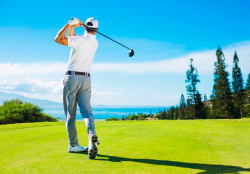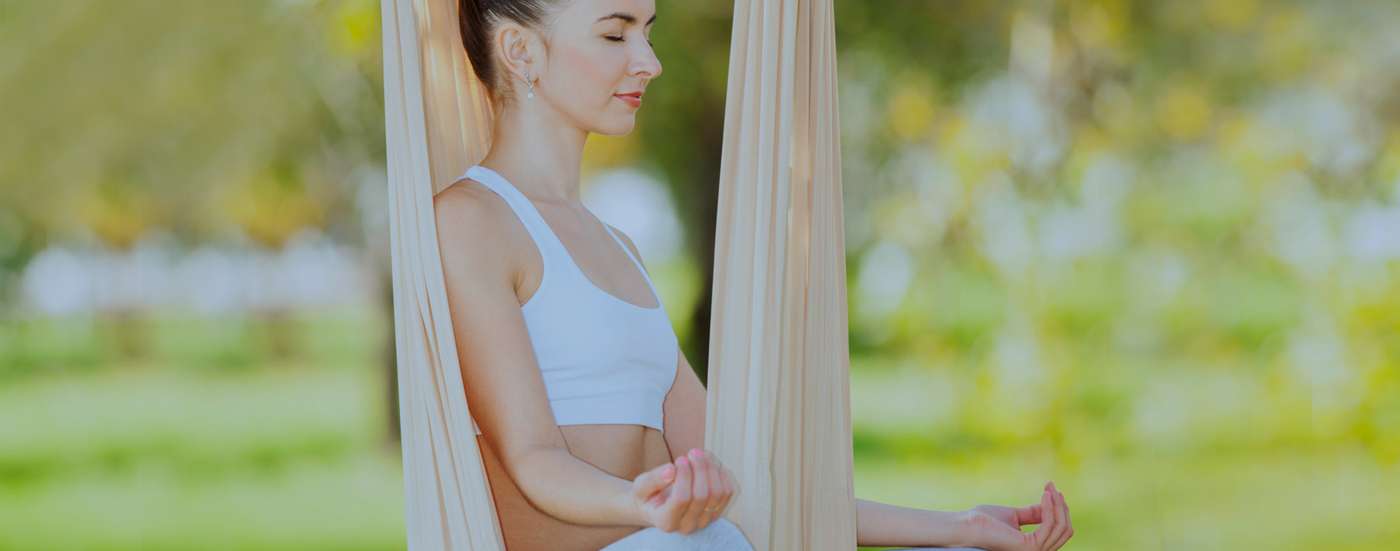Dar largos paseos al aire libre, dejarse llevar por el suave balanceo de un columpio, respirar y sentir cómo se expande la energía por el interior del cuerpo. Hay ejercicios que te conectan con el entorno y te re-conectan con tu propia naturaleza, disciplinas que te ayudan a fortalecer cuerpo y mente para lograr un equilibrio perfecto y una eficaz barrera contra el estrés.
GOLF
El golf, tal y como lo conocemos actualmente, tiene seis siglos de antigüedad y se remonta a la Escocia de principios del siglo XV donde se creó el primer campo y nacieron los primeros clubes. El primer escrito conocido en el que se regulaba este deporte está firmado en la población de St. Andrews en 1552. Desde entonces, el golf ha ganado adeptos – aseguran que es adictivo – y se ha popularizado universalmente por ser un deporte muy completo y relajante. En España, el primer club de golf se creó en Las Palmas (Gran Canaria) en el año de 1891.Como explica Yago Moreiras, profesor de la Escuela Alicante Golf, “el golf se consideraba un deporte elitista, solo accesible para gente mayor y con gran poder adquisitivo, pero se ha renovado y actualmente esto ya no es así, los precios para jugar y el acceso a los campos son cada vez más asequibles para todo tipo de familias. Yo tengo alumnos de todas las edades y de todos los sexos: desde niños que aun me vienen con el chupete (3/4 años), hasta edades mas veteranas, no hay limite de edad, hasta que el cuerpo, la mente y las ganas aguanten. El tipo de alumno no sigue un patrón, este es un deporte familiar en el que pueden jugar los abuelos con los nietos y pasar un fantástico día”. Lo que caracteriza al golf es, entre otras cosas, el escenario en el que se realiza, el campo, un gran espacio de hierba natural al aire libre, generalmente de 9 o 18 hoyos. “Los campos de golf, son extensiones de terrenos muy largas, con hoyos desde 100 metros, hasta hoyos de más de 500 metros (7/8km en total), ya solo el caminar estos hoyos, y realizar los movimientos para golpear la bola supone un esfuerzo cardiovascular muy recomendado”, apunta Yago. Una actividad física que ejercita, además, el sistema respiratorio, favorece la tonificación de los músculos y ejerce un efecto relajante al practicarse a un ritmo estable, sobre césped, respirando aire fresco y, en el mejor de los casos, bajo el sol.

A pesar de que no se trata de un ejercicio de impacto, sí es cierto que, dependiendo del terreno y del peso de la carga del golfista, es recomendable un entrenamiento previo – entre 15 y 20 minutos de estiramientos y carrera suave – que asegure una excelente condición física y prevenga lesiones.
El golf concentra los movimientos en los brazos y las extremidades superiores adquieren firmeza y fuerza, mejorando el tono de la espalda y el tórax. Pero en el momento del swing (ese giro maestro que precede al golpe de la bola) no sólo intervienen los músculos superiores si no que los lumbares, la fuerza abdominal y la articulación de cadera y rodillas son elementos esenciales para conseguir la coordinación y precisión que un buen golpe requiere.
El golf está especialmente recomendado para personas con problemas cardíacos, ya que se trata de un deporte dinámico pero de baja intensidad, por lo que también se recomienda en casos de problemas neurológicos leves y del sistema musculo-esquelético. Gracias a estos paseos al aire libre, además, se mantiene un buen nivel de tensión arterial, se aumenta el colesterol bueno y es un excelente método para relajarse y prevenir el estrés y la osteoporosis. “Y sí, engancha, es un deporte de superación y paciencia. Ese afán de superación, de pegarle más lejos, más alto, más recto, con efectos, de dominar diferentes golpes, esa superación personal y que nunca dejas de aprender cosas nuevas es lo que te hace adicto al golf”. Y recuerden siempre: el green es tu objetivo y el eagle tu victoria.
AEROYOGA
Si unes diferentes disciplinas como el Natha Yoga, el Mallakhmab Rope, el Ayurbeda y el Pilates, con la libertad de movimientos que te da el estar suspendido en el aire, aparece un deporte que es casi una forma de arte, es el AeroYoga.
Rafael Martínez, Licenciado en Bellas Artes y profesor de yoga con más de 30 años de experiencia, es el creador de esta disciplina (registrada y oficial en toda la UE) cuya base, cuenta él mismo en su web, “es el hecho de concebir el cuerpo humano como una obra de arte cuyo objetivo es la recreación, ya que por un lado es un método de disfrute y, por otro, una herramienta para recrearse en uno mismo y conseguir ser la persona que siempre hemos soñado”.
El AeroYoga se practica en un columpio que te permite jugar con la suspensión y la ingravidez, lo que resta presión al cuello, la columna y las piernas, que ya no tienen que soportar nuestro peso. Unos ejercicios controlados, una respiración adecuada y la corrección postural, logran potenciar las capacidades físicas y tonificar y estilizar los músculos. Al estar suspendidos en al aire, el recorrido de los movimientos es mayor y se mejora el riego sanguíneo, la circulación y el drenaje natural del cuerpo, liberándonos de toxinas y retención de líquidos.
Pero sus beneficios van más allá porque el AeroYoga es un método de crecimiento personal y potencia nuestras capacidades emocionales y mentales. El control total del cuerpo ayuda a controlar el estrés, a combatir fobias (hacer acrobacias aéreas sencillas aporta autoestima y seguridad) y aumenta la creatividad. Los ejercicios aéreos mejoran el flujo sanguíneo en la cabeza y la actividad cerebral, pero también elevan el estado de ánimo ya que la atención cuerpo-mente te conecta contigo mismo, te relaja y te permite lograr estados de sedación y sueño profundo. A volar se ha dicho.
FELDENKRAIS
“Cierra los ojos, imagina una línea que une tu omóplato derecho con tu omóplato izquierdo, piensa en cómo están apoyados sobre el suelo, qué parte de ellos ejerce más presión en la estera…” Imagina. Visualiza. Son los verbos más utilizados en una sesión de Feldenkrais, una terapia basada en la autopercepción y el movimiento para conocer nuestro propio cuerpo y tener un control total sobre él, aportándole bienestar.
“Es un método de educación somática”, explica Jaime Polanco, fisioterapeuta y profesor de Feldenkrais en Vivirenmovimiento, “que consiste en trabajar con movimientos suaves para que el sistema nervioso reconozca cómo puede haber una mejor organización para nuestro organismo completo, incluyendo la parte emocional, de pensamiento, de percepción…”
La terapia Feldenkrais pretende que la persona esté atenta al gesto que está realizando, comprendiendo las sensaciones que produce. La participación de nuestro cerebro es básica, es el receptor de estas nuevas informaciones y el que se encargará de registrarlas y automatizarlas para nuestra vida cotidiana. “El cerebro se alimenta de imágenes, y de imágenes del movimiento, así que si cambias las imágenes del movimiento, puedes cambiar el movimiento en sí. Es de lo que trata la autoconciencia a través del movimiento. Es un trabajo de autoimagen, la imagen que tienes de ti mismo, de los actos que realizas, de cómo te relacionas con tu entorno. Tu eres tus movimientos y si llegas al pleno potencial de ellos, cambian cosas en ti, tu optimismo, tus miedos, tu ansiedad…te sientes, si existe la expresión, plenipotente”.
El Método Feldelkrais (creado por Moshe Feldenkrais, Físico ucraniano, a mediados del S.XX) se apoya en conocimientos como el estudio de la neuroplasticidad -la capacidad de nuestro sistema nervioso de reorganizar sus conexiones en cualquier circunstancia-, el uso eficiente del esqueleto, el desarrollo motor infantil o la misma cibernética, es decir, cómo se comunican las diferentes partes de un sistema y cómo la posición de tu cabeza influye en tu pelvis o cómo tu pelvis afecta al uso de tus brazos.
Todo tipo de público puede practicarlo pero está especialmente recomendado en caso de tener dolores crónicos, artrosis, lumbálgias, osteoporosis, contracturas… “Hay también un importante trabajo sobre alteraciones neurológicas, parálisis cerebrales, hemiplégia, lesiones medulares, gente que necesita que su sistema nervioso reconecte cosas”, explica Jaime y, además, mejora también el rendimiento deportivo porque mejoras el uso de tu propio cuerpo.
Respira. Visualiza cómo el aire ensancha tus pulmones. Visualiza cómo se expande tu espalda. Imagina que eres “plenipotente”. Imagina.
Texto Bárbara Vidal

